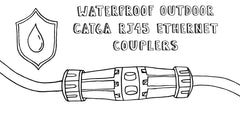Payment methods accepted

How To: Reterminate an IDC Connector
Written by Dave Harris, trueCABLE Technical Specialist, BICSI INST1 Certified
Sometimes when you terminate an Ethernet cable, the termination just doesn’t turn out right. Maybe it fails a test, or maybe it just doesn’t look good. If you terminate the cable with a crimp-on RJ45 modular plug, it gets cut off and thrown away. It can’t be reused. However, if you terminate the cable with a keystone jack or field termination plug, the connector can be reused up to twenty times. That's because keystone jacks and field termination plugs are not crimped on, they use Insulation Displacement Contacts (IDC) instead. Read on to see how to re-terminate an IDC connector.
IDC (Insulation Displacement Contact) Connector
IDC or Insulation Displacement Contact connectors are found in keystone jacks, patch panels, and field termination plugs. They consist of two nickel-tin plated phosphor-bronze electrodes (prongs). The prongs are positioned so that when an insulated wire is pushed down between them, a tiny bit of insulation is pushed away (displacement) while a secure electrical and mechanical connection is made as the prongs bite into the conductor. trueCABLE carries two types of IDC connection hardware: punch down and toolless.



Reterminating a Punch Down IDC Connector
If you need to re-terminate a punch down keystone jack, the first step is to remove the transparent IDC cover. This is done by squeezing the thumb latches on the cover to release it.
The next step is to pull the conductors from between the IDC prongs. Grasp the cable firmly, and pull the cable straight up and out of the prongs. This might require a little force, but the same channels that guide the conductors on the way in also guide them on the way out. This prevents any lateral force from damaging the prongs. Nevertheless, make a visual inspection of the prongs and the overall connector looking for damage or any other reason the connector might have failed a test. Also be sure to inspect the channels for any debris that may be left over from pulling the conductors out.
Cut off the used portion of the cable. Now you can terminate the connector again. The termination procedure can be reviewed in the blog, “How to: Terminate an Unshielded Punch Down Keystone Jack.”
Reterminating a Toolless IDC Connector
Toolless connectors are similar to the punch down variety, except that the conductors are positioned in a small plastic lacing cap, which is then trimmed, placed into the connector, and pushed down between the IDC prongs using a hinged cover as a lever.
The first step to re-terminate a toolless IDC connector is to remove any impediment to opening the hinged cover. In the case of a toolless keystone jack, there might be a zip tie keeping the connector closed. Snip off the zip tie with a small flush-cutter. If you are working on a shielded field termination plug, the strain relief boot will need to come off before the connector can be opened. For this, you’ll need a small flat-blade screwdriver to use as a lever to release the tiny latches.
The next step is to open the hinged lid. The same small screwdriver will be used to release the latches that hold the connector lid closed. For complete instructions for opening a toolless keystone jack, please refer to the blog, “How To: Open Shielded and Unshielded Tool-Less Keystone Jacks.” Instructions for opening toolless field term plugs can be found in “How To: Open Cat6A Shielded and Unshielded Field Term Plugs.”

A field term plug with its hinged cover open exposing the lacing cap.
When the connector is open, you can see the lacing cap installed in the connector. The next step is to remove the lacing cap. It’s held on pretty tight (one of the things that make IDC connectors so stable and secure), but it’s easily damaged, so try to be gentle as you remove it. Grasp the cap between your thumb and forefinger and rock it back and forth until it begins to work its way up and out of the IDC prongs. You might be able to use your little lever (screwdriver) to help work it out, but there is no provision for using a lever here, so be careful!
The conductors will come out along with the lacing cap. Be careful when you remove the conductors from the cap, because it’s easy to cause wear on the tiny plastic part, potentially making future terminations more difficult. Use your little screwdriver as a lever again to carefully pry out the wires, two at a time. Alternatively, you can use a small pair of needle-nose pliers to gently coax out the wires. Make a visual inspection of the prongs and the overall connector looking for damage or any other reason the connector might have failed a test.
Once the wires are removed from the lacing cap, cut off the used portion of the cable. Now you are ready to terminate the cable again.
Procedures for termination of toolless IDC connectors can be reviewed in:
How to: Terminate a Cat6A Field Term Plug, How to: Terminate a Shielded Toolless Keystone Jack, and How to: Terminate an Unshielded Toolless Keystone Jack.
HAPPY NETWORKING!!!
trueCABLE presents the information on our website, including the “Cable Academy” blog and live chat support, as a service to our customers and other visitors to our website subject to our website terms and conditions. While the information on this website is about data networking and electrical issues, it is not professional advice and any reliance on such material is at your own risk.


































